
The 6th Infantry Regiment ("Regulars") was formed 11 January 1812. Zachary Taylor, later the twelfth President of the United States, was a commander of the unit. The motto, "Regulars, By God!" derives from the Battle of Chippawa, in which British Major General Phineas Riall noticed that the approaching regiment had on the uniforms of militia, which the British had defeated at Queenston Heights. Instead, the Americans pressed the attack. Riall is believed to have said, "Those are Regulars, By God!", though the only source of this was opposing U.S. General Winfield Scott.

The 4th Marine Division is a reserve division in the United States Marine Corps. It was raised in 1943 for service during World War II, and subsequently fought in the Pacific against the Japanese. Deactivated after the war, the division was re-formed in 1966 and elements of the division deployed during the Gulf War in 1990–1991, as well as during the Iraq War. It is currently the ground combat element of the Marine Forces Reserve and is headquartered in New Orleans, Louisiana, and has units throughout the United States.
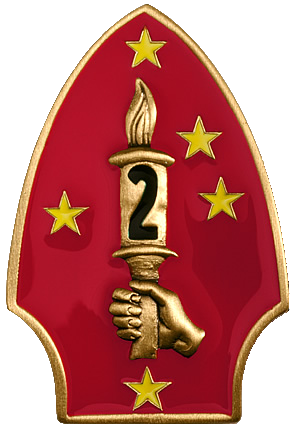
The 2nd Marine Division is a division of the United States Marine Corps, which forms the ground combat element of the II Marine Expeditionary Force. The division is based at Marine Corps Base Camp Lejeune, North Carolina and headquartered at Julian C. Smith Hall.

1st Light Armored Reconnaissance Battalion is a fast and mobilized armored terrestrial reconnaissance battalion of the United States Marine Corps. Nicknamed the "Highlanders," their primary weapon system is the LAV-25 Light Armored Vehicle armed with the M242 25mm Bushmaster chain gun. They fall under the command of the 1st Marine Division and the I Marine Expeditionary Force. The unit is based out of the Marine Corps Base Camp Pendleton, California.

2nd Light Armored Reconnaissance Battalion is a fast and mobilized armored terrestrial reconnaissance battalion of the United States Marine Corps. Their primary weapon system is the 8-wheeled LAV-25 and they fall under the command of the 2nd Marine Division and II Marine Expeditionary Force. The unit is based out of the Marine Corps Base Camp Lejeune, North Carolina. The current mission statement of the battalion is: To perform combined arms reconnaissance and security missions in support of the Ground Combat Element (GCE) of a Marine Air-Ground Task Force (MAGTF). Its mission is to conduct reconnaissance, security and economy of force operations, and, within its capabilities, limited offensive or defensive operations that exploit the unit's mobility and firepower.
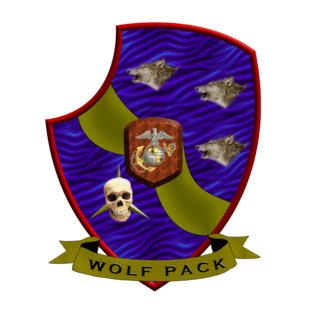
3d Light Armored Reconnaissance Battalion(3D LAR BN) is a fast and mobilized armored terrestrial reconnaissance battalion of the United States Marine Corps. Their primary weapon system is the LAV-25 and they are part of the 1st Marine Division and I Marine Expeditionary Force. The unit is based out of the Marine Corps Air Ground Combat Center Twentynine Palms, California.
Radio Battalions are tactical signals intelligence units of Marine Corps Intelligence. There are currently three operational Radio Battalions in the Marine Corps organization: 1st, 2nd, and 3rd. In fleet operations, teams from Radio Battalions are most often attached to the command element of Marine Expeditionary Units.
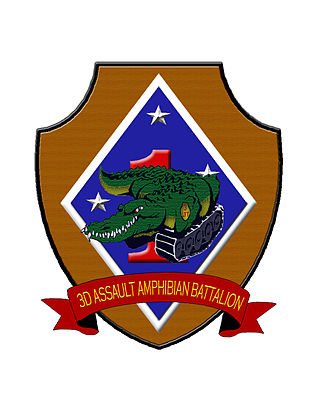
3rd Assault Amphibian Battalion is one of two active duty assault amphibian battalions in the United States Marine Corps. The battalion's primary weapon system is the Amphibious Assault Vehicle or AAV. The AAV is a 27.5-ton armored vehicle that carries up to 21 combat-loaded Marines and is armed with the UGWS, which mounts a .50 cal (12.7 mm) M2HB machine gun and a Mk-19 40 mm grenade launcher. The battalion is also equipped with the Amphibious Combat Vehicle or ACV, a rather new variant to the USMC’s amphibious armament which will replace the AAV in years to come. The AAV and ACV are the only armored vehicles in the U.S. inventory that are fully capable of operations both on land and in the ocean. The battalion is part of the 1st Marine Division and the I Marine Expeditionary Force. The unit is based in Camp Pendleton, California.

2nd Battalion, 23rd Marines (2/23) is a reserve infantry battalion in the United States Marine Corps located throughout the Western United States consisting of approximately 1000 Marines and Sailors. They fall under the command of the 23rd Marine Regiment and the 4th Marine Division.

3rd Battalion, 23rd Marine Regiment (3/23) is a reserve infantry battalion in the United States Marine Corps located throughout the Southern United States consisting of approximately 800 Marines and Sailors. The battalion was first formed in 1943 for service in the Central Pacific Area during World War II, taking part in a number of significant battles including those at Saipan and Iwo Jima before being deactivated at the end of the war. In the early 1960s, the unit was reactivated as a reserve battalion. The battalion is headquartered in Saint Louis, Missouri, with outlying units throughout the Southern United States. 3/23 falls under the command of the 23rd Marine Regiment and the 4th Marine Division. Recent operations have included tours in Iraq and Afghanistan.

3rd Battalion, 24th Marines (3/24) was a reserve infantry battalion in the United States Marine Corps. The battalion was first formed in 1943 for service in the Pacific Theater of Operations during World War II, taking part in a number of significant battles including those at Saipan and Iwo Jima before being deactivated at the end of the war. In the early 1960s, the unit was reactivated as a reserve battalion. It was located throughout the Midwestern United States and consisted of approximately 800 marines and sailors. The battalion was part of the 24th Marine Regiment and the 4th Marine Division. Recent operations included tours in Iraq and Afghanistan. On May 19, 2013, the battalion was deactivated (retired) as a part of 2013 Marine Corps Force Restructuring, along with the 24th Marine Regiment. 3/24 personnel were reallocated to 23rd Marine Regiment, with the majority of the companies becoming 3rd Battalion, 23rd Marines.

4th Assault Amphibian Battalion is a mechanized battalion of the United States Marine Corps Reserve. Their primary weapon system is the AAV-P7/A1 Amphibious Assault Vehicle and they are part of the 4th Marine Division of the Marine Forces Reserve. The unit is based out of Tampa, Florida, with subordinate units in Florida, Virginia and Texas.
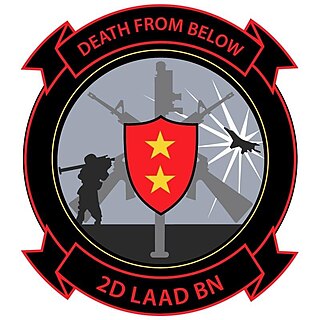
The 2d Low Altitude Air Defense Battalion is an air defense unit of the United States Marine Corps. The battalion is subordinate to Marine Air Control Group 28 (MACG-28) and the 2nd Marine Aircraft Wing and is currently based at Marine Corps Air Station Cherry Point. The battalion is composed of one Headquarters and Support Battery and two Firing Batteries.
The 64th Armor Regiment is an armor regiment of the United States Army, organized under the United States Army Regimental System. It is descended from the 758th Tank Battalion (Light) that served in the Italian campaign during World War II. Redesignated as the 64th Tank Battalion, it was assigned to the 3rd Infantry Division during the Korean War and it spent most of the Cold War stationed in West Germany before elements were transferred to Ft. Stewart, Georgia in the late 1990s. The regiment participated in Desert Shield, Desert Storm, Desert Fox, Desert Spring, Operation Iraqi Freedom and Operation Enduring Freedom.
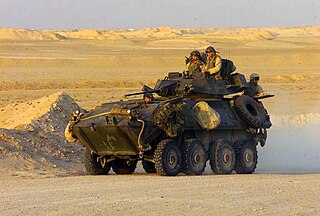
The United States Marine Corps Light Armored Reconnaissance Battalions, or LAR Battalions, are fast and mobilized armored terrestrial reconnaissance units that conduct reconnaissance-in-force (RIF) ahead of the battalion landing teams or division infantry forces. They mainly provide the Marine Air-Ground Task Force and the Marine Expeditionary Unit commanders vital intelligence of the enemy.

1st Force Reconnaissance Company conducted deep reconnaissance and direct action raids in support of I Marine Expeditionary Force requirements across the range of military operations to include crisis response, expeditionary operations and major combat operations. 1st Force Recon Company was deactivated on 26 October 2006 and the majority of the personnel were used to establish the 1st Marine Special Operations Battalion.

3rd Force Reconnaissance Company is a force reconnaissance unit of the United States Marine Corps Reserve. The company is located in Mobile, Alabama.

The 34th Armor Regiment is an armored regiment of the United States Army formed in 1941.

The 103rd Armor Regiment is an armored regiment in the Pennsylvania National Guard first formed in 1941. Its legacy unit, 3rd Battalion, 103rd Armor, is a subordinate command of the 55th Heavy Brigade Combat Team, 28th Infantry Division.





















